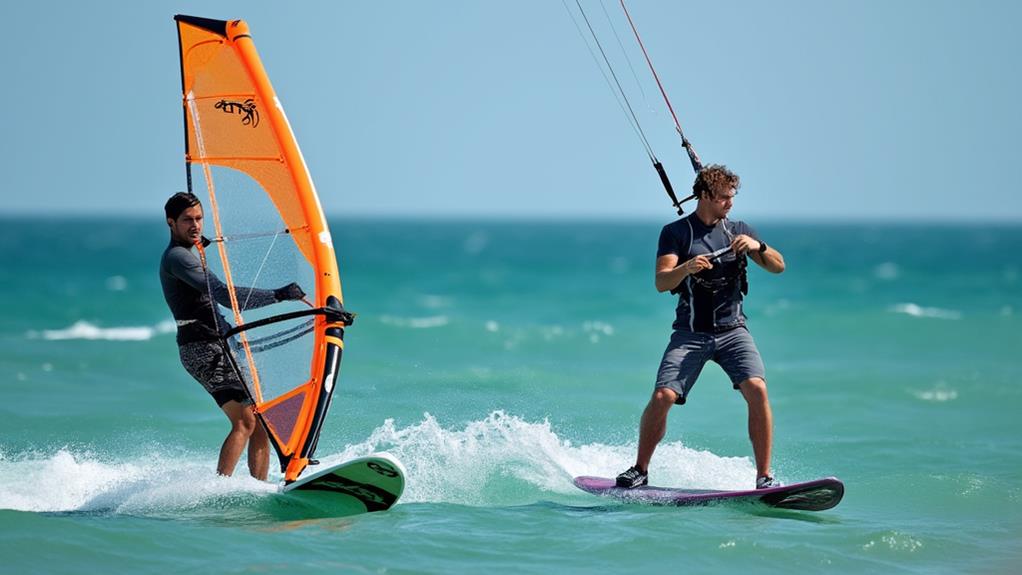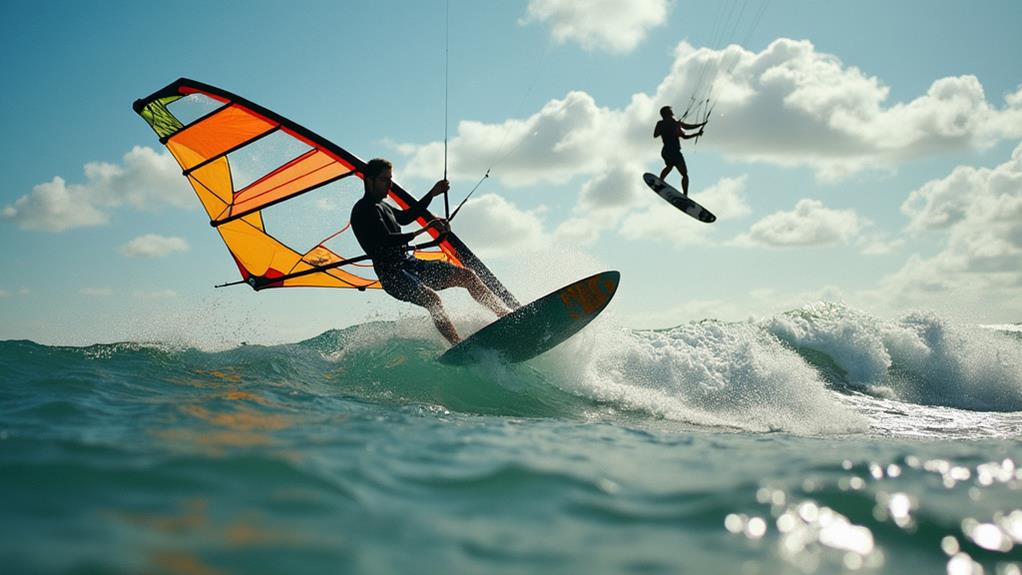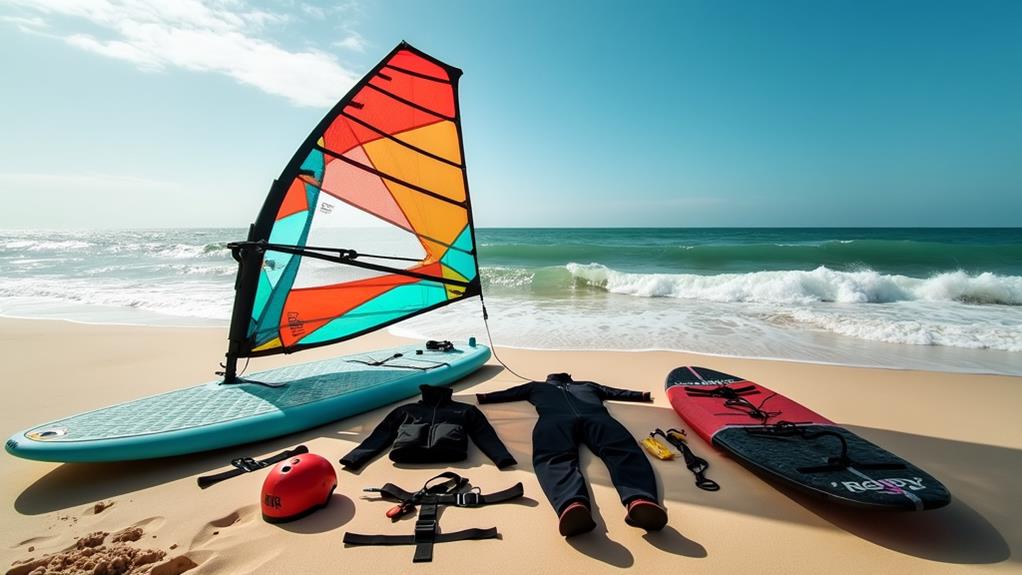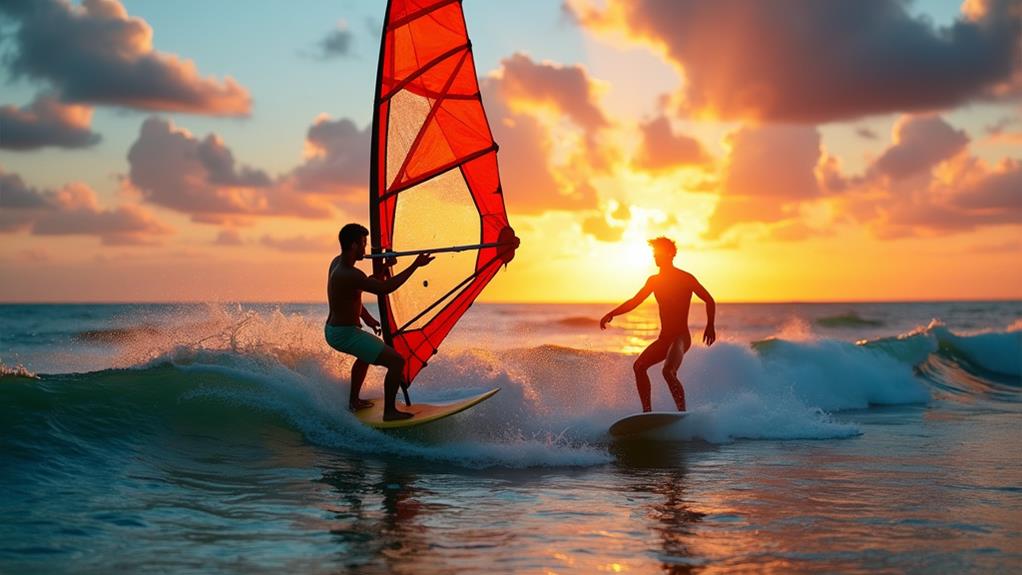Is Windsurfing Easier Than Kitesurfing?

Deciding whether windsurfing or kitesurfing is easier depends on various factors. Windsurfing might seem simpler at first, as many beginners achieve basic skills on flat water within a few hours. However, mastering advanced techniques like tacking and gybing can take considerable time. Conversely, kitesurfing demands more physical effort and initial training, which can be daunting. Yet, once the basics are learned, progression can be rapid. Ultimately, the choice depends on your preferences and physical abilities. Let's explore the nuances that might influence your decision.
Equipment and Transport
When comparing windsurfing and kitesurfing, the equipment and transport differences are notable. Windsurfing gear, weighing around 30 kg, includes large boards and sails, making transport challenging, often requiring larger vehicles. In contrast, kitesurfing gear is more portable, consisting of a single board and kite that can be easily carried under one arm. This compact design is ideal for those with limited storage space or who travel frequently.
Storage is another area where kitesurfing excels. Windsurfing equipment requires substantial space due to its size and multiple components, whereas kitesurfing gear is compact, fitting easily in smaller environments. This is particularly beneficial for those living in small apartments or needing to store gear in tight spaces.
In terms of maintenance, windsurfing equipment generally lasts longer, around 5-6 years with proper care. Kitesurfing gear, particularly the lines, requires more frequent replacement, typically every 3 years, due to its lighter and more fragile materials. Both sports have similar gear costs, ranging from €1000 to €2500 for new equipment. However, the portability and compact nature of kitesurfing gear provide a clear advantage for transport and storage.
Learning Curve
Exploring the learning curve of windsurfing and kitesurfing reveals some key differences. Windsurfing is generally easier to pick up initially, with beginners often achieving a level of independence within 2-3 hours on flat water. The larger boards and slower speeds facilitate confidence in sail control and board maneuvering, making the sport seem more accessible at the start.
In contrast, kitesurfing requires about 9 hours of initial training focused on kite control and body dragging. The steeper learning curve is due to the immediate need to master kite handling, which demands consistent monitoring. Although it may feel more challenging at the beginning, most people reach comparable speed and technique within around 20 hours.
As you progress in windsurfing, mastering techniques like tacking and gybing can become complex. This gradual learning curve might make windsurfing feel more approachable initially but presents its own challenges over time. On the other hand, kitesurfing's early stages require greater physical effort in controlling the kite but become more straightforward as you advance.
Ultimately, both sports emphasize different skills during the learning process. Windsurfing may feel easier to learn initially due to its slower, more gradual approach, while kitesurfing demands more effort upfront but offers quicker progression once the basics are mastered.
Physical Demands

Windsurfing and kitesurfing demand different levels of physical exertion. Windsurfing requires significantly more overall body strength and stamina, engaging nearly all muscle groups. Managing both the sail and the board simultaneously demands high levels of dexterity and core strength, often leading to muscle soreness after sessions due to its extensive physical demands.
In contrast, kitesurfing primarily targets the quadriceps and involves less overall physical exertion. The use of a waist harness for power distribution reduces the need for body strength, resulting in less fatigue and muscle soreness for kitesurfers.
Swimming skills are essential for both sports, but their physical demands differ. Windsurfing is more challenging due to the constant need for balance and control, requiring higher stamina and engaging all muscle groups. Kitesurfing, with its reliance on the waist harness, is generally less strenuous and demands lighter physical exertion.
Safety Considerations
Safety considerations are crucial when choosing between windsurfing and kitesurfing. For beginners, it's important to recognize that kitesurfing generally poses greater risks. Accidents in kitesurfing tend to be more severe due to high-speed falls and potential collisions caused by poor kite management. In contrast, windsurfing accidents are typically less frequent and usually affect only those within a 5-meter radius downwind, making it a safer option for newcomers.
Both sports require proper training and diligent equipment maintenance. However, kitesurfers must have a more comprehensive understanding of safety procedures to prevent accidents. For instance, kitesurfing gear should be launched with assistance to ensure safety, whereas windsurfing can often be initiated independently.
Using safety gear, such as emergency whistles, is advised for both sports to enhance overall safety awareness and preparedness. As a beginner, investing time in learning these safety considerations can significantly reduce the risk of accidents.
Community and Culture

Understanding the safety aspects is essential, but it's equally important to explore the community and culture surrounding windsurfing and kitesurfing. Windsurfing boasts a distinct community rich with diverse equipment and techniques, fostering a strong sense of camaraderie among enthusiasts. This sport is filled with personal stories of returning windsurfers, highlighting the deep bonds within the community.
Kitesurfing, in contrast, attracts a more casual and relaxed crowd. Its culture prioritizes freedom and versatility on the water, appealing to those who crave spontaneous experiences. The kitesurfing community often includes individuals who value ease and fun, creating a different but equally strong camaraderie.
Both sports offer unique experiences:
- Windsurfing: Strong bonds and personal stories.
- Kitesurfing: Casual and relaxed atmosphere.
- Windsurfing: Diverse techniques and equipment.
- Kitesurfing: Freedom and versatility.
These distinctions create varied social dynamics, making each sport special in its own right. Whether you're drawn to the camaraderie of windsurfing or the spontaneous freedom of kitesurfing, you'll find a community that resonates with your style.




